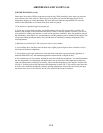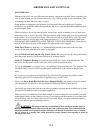AIRSTREAM LAND YACHT GAS
TIPS TO CONTROLLING CONDENSATION (continued)
The natural tendency would be to close the vehicle tightly during cold weather. This will actually compound
the problem. Simply put, you need to remove some of the warm air, and allow some cool outside air to
get inside the vehicle, so the furnace will not recycle the humid interior air.
Use fluorescent ceiling lights and minimize prolonged use of incandescent lights, which produce heat and
contribute to condensation in the roof above the ceiling lights.
ABOUT MOLDS
What are molds?
Molds are microscopic organisms that naturally occur in virtually every environment, indoors and out.
Outdoors, mold growth is important in the decomposition of plants. Indoors, mold growth is unfavorable.
Left unchecked, molds break down natural materials, such as wood products and fabrics. Knowing the
potential risks is important for any type of homeowner to protect their investment.
What factors contribute to mold growth?
For mold growth to occur, temperatures, indoor or outdoors, must be between 40 degrees and 100 degrees
Fahrenheit and also have a source of moisture, such as humidity, standing water, damp materials, etc.
Indoors, the most rapid growth occurs with warm and humid conditions.
How can mold growth be inhibited?
By controlling relative humidity, the growth of mold and mildew can be inhibited. In warm climates, use
of the air conditioner will reduce the relative humidity. Vents are located in the bathing and cooking areas
and constant use is advised during food preparation and bathing, even during colder weather. Additionally,
opening a window during these activities will assist in ventilation. In extremely humid conditions, the use
of a dehumidifier can be helpful.*
Frequent use of your RV or cleaning regularly is an important preventive measure. Further, any spills
should be wiped up quickly and dried as soon as possible. Avoid leaving damp items lying about. On safe
surfaces, use mold or mildew killing cleaning products. Check sealants regularly, and reseal when
necessary to avoid water leaks. Proper preventive maintenance to the RV and its accessories, as described
both in this manual and in accompanying literature, will provide the best protection to the RV.
For more information of controlling moisture in the RV, please read, “Tips to Controlling Condensation,”
located in this manual.
*If using a dehumidifier, please read and follow all manufacturer instructions and recommendations to the
use and cleaning of the dehumidifier.
D-11


















